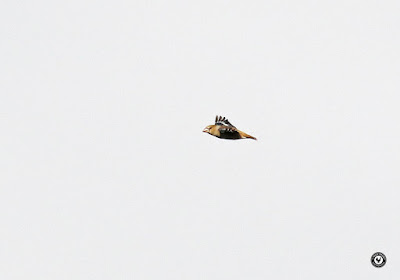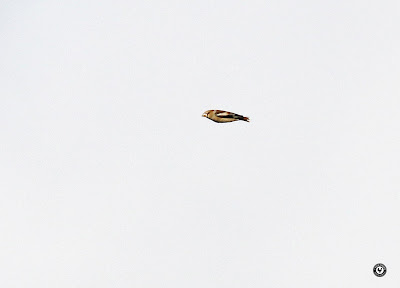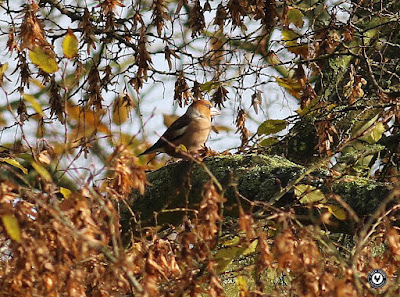There is a local BBOWT reserve that provides a winter refuge for bitterns. Usually later in the year but one has already been seen and photographed there during the past month. We tried in vain for a view a fortnight ago so went for another go. Also a couple of bearded tits had been reported at the same site so we were hopeful of finding and seeing both.
On a Tripadvisor rating the hide would score less than 1 star for its appointment value; no door, freezing cold, very basic, stale ambience etc. But for location it gets a 5 star; superb views of a lake and more importantly a reedbed. Maybe time for BBOWT to upgrade the facilities? Although I do realise that previous hides have been vandalised so perhaps they'd be no point. The reedbed is where up to 3 bitterns have been seen in the past. Mrs Caley and I have had great views of these skulking waterbirds over the last two winters here as the photos below illustrate.
 |
| bittern |
 |
| goldeneye (female) |
 |
| little grebe |
There are 3 channels cut into the reedbed, I imaginatively call them the left-hand, middle and right-hand channels. The bitterns are normally encountered wading across these channels, particularly the left and right. Ten minutes into our vigil I noticed a small bird flitting amongst the lower stems on the right hand side of the middle channel. Could it be one of the bearded tits? Unfortunately not but it did turn out to be a fine cetti's warbler although it disappeared as quickly as I could get the camera on it! We kept surveying the various channels and were rewarded, not with a bittern, but with a water rail scurrying rapidly across the right-hand channel. Now in my experience here, if a water rail runs across one of the side channels it will then move slowly through the adjacent patch of reeds and then emerge at the edge of the main channel and then fly across that to the next reed stand. It flies rather than walks because the middle channel is much wider and the bird doesn't want to be out in the open for long. It will then move through the next patch of reeds before either running or swimming across the other side channel. This water rail did exactly that, except when it emerged at the edge of the reeds and flew across the main channel I wasn't ready with the camera and all I managed was a few out of focus shots.
 |
| water rails, they move so fast! |
I was ready however when it swam across the left hand channel!
 |
| water rail |
 |
| sick lesser black-backed gull |
 |
| healthy lesser black-backed gull |
After almost 2 hours and no bittern sightings another water rail made the right to left journey across the reeds. This time I was quick enough to capture it in flight but the camera focusing wasn't! C'est la vie! Interestingly though, as the blurry photo below proves, this water rail had caught a small fish.
 |
| water rail with fish supper |
Apart from seeing a sparrowhawk getting mobbed and then ousted from some bushes on the other side of the lake by a magpie and a crow not much else happened. A grey heron reclaimed the bushes and looked rather incongruous stood there, and grey wagtail fed along the waters edge.
 |
| grey heron |
 |
| grey wagtail |
Sadly no appearance from either a bittern or a bearded tit but an enjoyable couple of hours nevertheless.
We drove across to Great Hampden near to Princes Risborough to hopefully see some hawfinches. The country is alive with hawfinches this autumn with thousands pouring into all areas from the continent. This irruption, as it is called, is thought to be the result of the main food sources failing on their home territories forcing the birds to migrate in search of sustenance. Mrs Caley and I were lucky to find some in Cornwall (see my previous blogs) and I saw a flock of 15 flying over close to Deddington a few weeks ago, so we'd already had some views of them. But on the Great Hampden estate there have been as many as 40 hawfinches feeding in some hornbeam trees that sit in the middle of a kale field so it seemed like a good idea to have a bash at them. We arrived at the designated parking spot at Redland End and made our way through beautiful mixed woodland to the edge of the kale field. There was nobody else around but the isolated stands of hornbeams were obvious so I set up the scope and zoomed into the tree tops.
 |
| The hornbeam stand in the kale field |
Nothing! I searched from one group of trees to another and then back again. I searched the woodland further away. Still nothing! I looked at trees even further away but could only find a jay and some red kites. But it doesn't pay to be impatient in this game so I scanned again. And again. Then after about 15 minutes a chunky little bird flew in and landed right at the top of one of the hornbeams. A hawfinch! I focussed the scope to let Mrs Caley have a good view and was astonished to see another 2 perched close by the first. Where did they come from? They were definitely not there earlier! Anyway we took our fill and decided to move closer to the trees. Luckily the field is intersected by a muddy footpath which we followed and set up beneath an old (ash) tree about 75 yards away from the trees in which the hawfinches were now feeding.

They were joined by more flying in from the right (east) and I estimated as many as 15 were now in the trees that we watched. They could be quite difficult to see at times as they moved amongst the branches and leaves but there were usually one or two affording good clear views. Mrs Caley pored through the scope whilst I set about trying to obtain some images at least to better the rubbish ones that I managed in Cornwall. It wasn't easy (is it ever?) since the birds were so far away so it was only ever going to be record shots. It was a damp overcast afternoon too. The usual complaints from a wannabe photographer who doesn't really know how to get the best out of his camera!
 |
| More hawfinches arriving |
 |
| "Group" shots with hawfinches highlighted |
But our luck was in even further when the group of birds flew out of the trees in front of us to a small copse further along the path. The footpath went straight through the trees so I was able to "stealthily" approach and get some much closer views and I hoped some better photos. The only drawback this time was that the trees were so bloody high!
 |
| The copse with the footpath running through it. |
Then our biggest stroke of luck, the sun came out! For just 10 minutes we were blazed in afternoon glory. Now I had a chance of nailing a half decent shot of some hawfinches. They were still at some distance but the camera now had a good opportunity to make up for my own failings. I'm quite happy with a couple of them.
It was great to watch them since they are normally so difficult to see well. Hawfinches are usually very shy and unassuming finches despite their bulk and are very quiet too so can be hard to locate. These were easy to see though and you could even hear the cracking noises made as they opened the hornbeam keys with those massive triangular bills. We spent nearly two hours watching them and apart from two couples who walked past (and enjoyed seeing their first hawfinches through my scope), we didn't see another soul. Mind you the hawfinches have been present for over a fortnight so most local birders will have had their fill by now.
An afternoon to remember I think and a pretty good day all round despite not seeing a bittern or bearded tit earlier. Mrs Caley and I agreed that if the hawfinches stay around then another visit will definitely be in order, particularly on a sunny day.






























Superb read
ReplyDeleteThanks Graham, much appreciated!
ReplyDelete